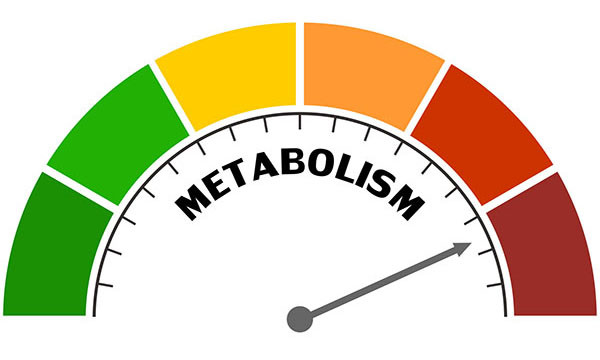Surprising findings about metabolism and age

According to recent findings published in Science, metabolism reaches its peak much earlier in life and slows down much later than we previously thought. Before delving into the details of the new research, let's define a few terms.
Metabolism is the combination of all the chemical processes that allow an organism to sustain life. For humans, this includes conversion of energy from food into energy for life-sustaining tasks such as breathing, circulating blood, building and repairing cells, digesting food, and eliminating waste.
The minimum amount of energy needed to carry out these basic processes while an organism is fasting and at rest is known as the basal metabolic rate, or BMR, which can be calculated using a variety of online calculators that take into account an individual's height, weight, age, and sex. BMR is often referred to as resting metabolic rate, or RMR. Total energy expenditure (TEE) is a combination of BMR, plus energy used for physical activities and energy used to digest food (known as dietary thermogenesis). For sedentary adults, BMR accounts for about 50% to 70% of total energy output, dietary thermogenesis for 10% to 15%, and physical activity for the remaining 20% to 30%.
We know certain factors affect energy expenditure, such as age, sex, body mass, body composition, physical activity, and illness, yet the latest comprehensive study, which included data from people around the world, revealed surprising information about the timing of age-related metabolism changes over the lifespan.
Who participated in the study?
6,421 subjects (64% female) between the ages of 8 days and 95 years old from 29 countries around the world participated in the study.
What did the study entail?
Researchers calculated TEE in all subjects using doubly labeled water measurements (the gold standard for measuring energy expenditure). They used additional datasets, mathematical models, and adjustments to account for differences in body size, age, and reproductive status. Their findings revealed four distinct phases of adjusted total and basal energy expenditure over the lifespan.
What were the study findings?
The phases of energy expenditure described by the study are as follows:
Neonatal (1 month to 1 year): Neonates in the first month of life had size-adjusted energy expenditure similar to that of adults. Energy expenditure increased rapidly over the first year, reaching a peak at 0.7 years old. Subjects between 9 and 15 months had adjusted energy expenditures nearly 50% higher than those of adults.
Childhood and adolescence (1 to 20 years): Although total and basal expenditure as well as fat-free mass continued to increase with age throughout childhood and adolescence, size-adjusted expenditures steadily declined throughout this period. Sex had no effect on the rate of decline. At 20.5 years, adjusted TEE and RMR reached a plateau to that of adult levels. Of note, there was no increase in adjusted total or basal energy expenditure during the pubertal ages of 10 to 15 years old.
Adulthood (20 to 60 years): Total and basal expenditure and fat-free mass were all stable from ages 20 to 60, regardless of sex. Adjusted TEE and RMR remained stable even during pregnancy, and any increase in unadjusted energy expenditure during pregnancy was accounted for by the increase in body mass. The point at which adjusted TEE started to decline was age 63, and for adjusted BMR was age 46.5 (although the researchers indicate a small number of BMR measurements reduced their confidence in this estimate).
Older adulthood (andgt;60 years): At approximately 60 years old, TEE and BMR began to decline, along with fat-free mass and fat mass. However, declines in energy expenditure exceeded that expected from reduced body mass alone. Adjusted TEE and BMR declined by 0.7% per year, and for subjects 90 years old and greater, adjusted total expenditure was about 26% below that of middle-aged adults.
Additional study findings
The study authors were interested in effects of physical activity and tissue-specific metabolism (the idea that some organs, such as the brain and liver, use more energy than other organs, and constitute a higher percentage of body weight in younger individuals) across the lifespan. Through various modeling scenarios, they determined that age-related changes in physical activity level and tissue-specific metabolism contribute to TEE across different ages; in particular, elevated tissue-specific metabolism in early life may be related to growth or development, while reduced energy expenditure in later life may reflect organ-level metabolic decline.
What are the take-home points of this study?
This study challenges previously held beliefs that metabolism correlates closely with organ-specific metabolic activity throughout growth and development, such that it is very high in infancy, childhood, and adolescence, and progressively declines throughout adulthood and old age. Instead, the authors observed that BMR was 30% higher than would be expected based on body and organ composition in children 1 to 20 years old, and 20% lower than expected in adults 60 and above. These deviations in expected TEE and BMR in childhood and old age support the notion that age-related metabolic changes may play a more important role than we previously gave them credit for. What's more, these results strongly suggest we may no longer be able to blame weight gain in middle age on a slowed metabolism.
What can individuals do to promote weight management throughout life?
We must also acknowledge there are individual variations in energy expenditure that may affect a person's weight trajectory or response to weight management strategies. However, the study findings do not negate our current understanding of how to achieve and maintain a healthy weight throughout life. Evidence still strongly supports
- eating a healthy, balanced diet consisting primarily of whole foods in the form of fruits, vegetables, lean protein, and whole grains
- maintaining an active lifestyle with a goal of at least 150 minutes of physical activity a week, including strength training to increase or maintain lean muscle mass
- getting adequate rest, which for most individuals is seven to eight hours of sleep daily
- managing stress through mindfulness, meditation, or other relaxing activities.
Follow Dr. Stanford on Twitter and Instagram @askdrfatima and Dr. Anekwe on Twitter @Chikagirl and on Instagram @chikavera
About the Authors

Fatima Cody Stanford, MD, MPH, MPA, FAAP, FACP, FTOS, Contributor

Chika Anekwe, MD, MPH, Contributor; Editorial Advisory Board Member, Harvard Health Publishing
Disclaimer:
As a service to our readers, Harvard Health Publishing provides access to our library of archived content. Please note the date of last review or update on all articles.
No content on this site, regardless of date, should ever be used as a substitute for direct medical advice from your doctor or other qualified clinician.













